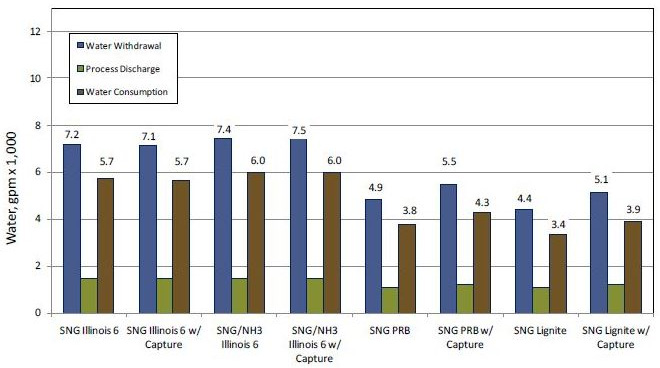Water Usage in Synthetic Natural Gas (SNG) or Ammonia Synthesis Scenarios
by Rudy P. SysAdmin at howtofindthemoneyThe foregoing discussion related to power generation scenarios. When coal gasification is the basis for production of hydrogen, synthetic natural gas, or ammonia, water usage is expected to change as a function of the many process differences between power generation and fuels, chemicals, or fertilizer synthesis. One of the recent Cost and Performance Baselines for Fossil Energy Power Plants, "Volume 2 - Coal to Synthetic Natural Gas and Ammonia (Various Coal Ranks)" establishes performance and cost data for coal fueled plants producing synthetic natural gas, and coproduction of synthetic natural gas (SNG) and ammonia, based on a dry-feed entrained-flow gasifier and include cases using bituminous, sub-bituminous, and lignite coals, and in configurations with and without carbon sequestration.
A water balance was performed for each case on the major water consumers in the process. The total water demand for each subsystem was determined and internal recycle water available from various sources like boiler feedwater (BFW) blow-down and condensate from syngas was applied to offset the water demand. The difference between demand and recycle is raw water withdrawal. Raw water withdrawal is the water removed from the ground or diverted from a surface-water source for use in the plant. Raw water consumption is also accounted for as the portion of the raw water withdrawn that is evaporated, transpired, incorporated into products or otherwise not returned to the water source it was withdrawn from. Results of the water balance for the various cases are shown in the following graph:

Raw water withdrawal and consumption, SNG and Ammonia Synthesis
The primary observations that were drawn are:
- In all cases, the primary water consumer is cooling tower makeup, which ranges from 60 to 80 percent of the total raw water withdrawal. The bituminous coal cases utilized a mechanical draft, evaporative cooling tower, and all process blow-down streams were assumed to be treated and recycled to the cooling tower. It was assumed that the Powder River Basin (PRB) and North Dakota Lignite (NDL) coal cases utilized a parallel cooling system with half of the turbine exhaust steam condensed in an air-cooled condenser and half in a water-cooled condenser.
- The SNG and ammonia co-production cases (third and fourth cases in graph) consume approximately 5 percent more water than the SNG only cases using bituminous coal (first and second cases in graph). This is largely due to the excess shift steam required to produce the hydrogen necessary for ammonia production.
- For the SNG only non-sequestration cases, the case using lignite coal requires the least amount of water withdrawal followed by the cases using PRB coal and bituminous coal. The relative raw water withdrawal for the SNG only cases is 1.6:1.1:1.0 (bituminous:PRB:lignite). The trend for the SNG only cases with carbon sequestration is 1.4:1.1:1.0 (bituminous:PRB:lignite).
Biomass Gasification and Water Use
Although IGCC is the application of gasification for which water use is most significant, the technology can offer water use advantages in some biomass energy applications. Biomass power plants have similar water use characteristics to coal plants. In addition, in some industrial processes, particularly in the paper and sugar industries, gasification can replace combustion technologies. The technology allows for the conversion of both biomass solids and black liquor into a gas that can fuel various processes or turn a gas turbine to provide electricity.
The 10 largest coal producers and exporters in Indonesia:
Sponsor Ads
Created on Jul 11th 2019 00:41. Viewed 416 times.
Comments
No comment, be the first to comment.



